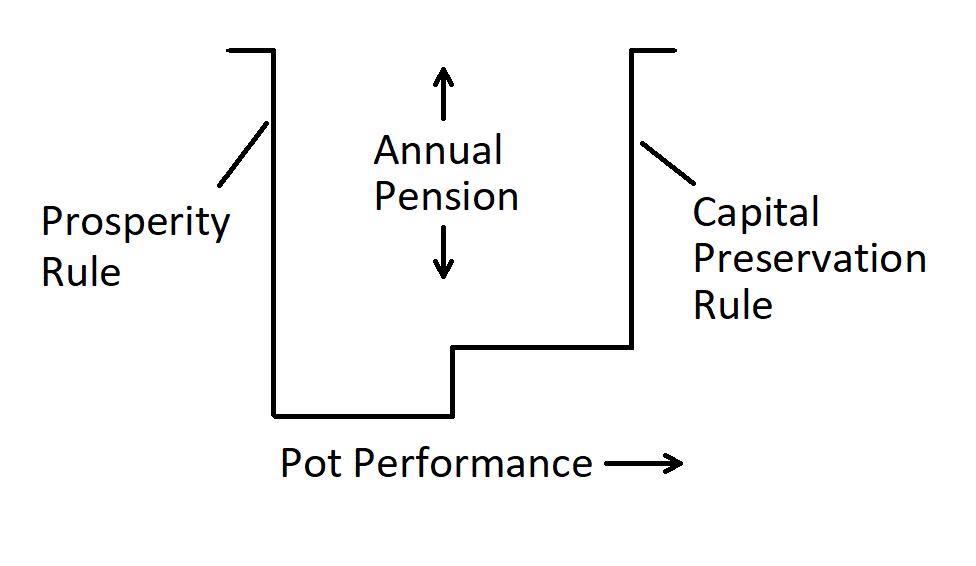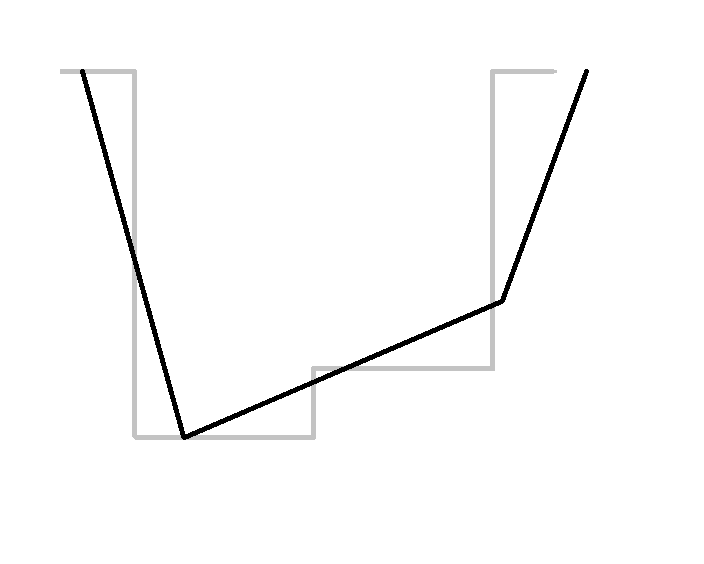We’d like to remind Forumites to please avoid political debate on the Forum.
This is to keep it a safe and useful space for MoneySaving discussions. Threads that are – or become – political in nature may be removed in line with the Forum’s rules. Thank you for your understanding.
Foolishness of the 4% rule
Comments
-
The issue is that the calculation is nonsensical if you are intending to apply it to the future as a constant SWR.1
-
They could be, but I think in most cases they won't be increasing their spending by that much taking the SP at 66. If I was deferring until 70, there could be around £36k less in my pot at 70 because I would be spending from that rather than from my SP.jamesd said:
The spouse is presumably benefitting from the higher overall household spending so they aren't actually losing out.Audaxer said:
But if you have a spouse, and you were to pass away before you had recouped the deferred pension, your overall pot left to your spouse could be much lower than it would have been if you hadn't deferred. Even more so if you had been more aggressive with your DC drawdown.0 -
Not to forget that IFAs quite simply have to err on the side of caution all the time for all clients.IvanOpinion said:I remember reading some articles recently in which various IFAs discussed the SWR. The overall consensus seemed to be that they would suggest 3.25-3.5% to their clients.
So, working on the assumption that they will, on average, be charging fees of about 0.5%-1%, and will probably be erring on the side of caution, then, assuming you do not use an IFA, that would put the SWR in the ballpark of 4%.
Their business would collapse if a number of customers flagged up running out of money on their advice!
If one is proactively monitoring and being flexible with one's spending plans month to month, that SWR could clearly therefore be a higher number when compared with one that is set on an annual basis over the annual lunchtime conversation 😉
Plan for tomorrow, enjoy today!0 -
jamesd said:
...In subsequent years, first take the previous year's income and increase it by uncapped inflation unless portfolio total return was negative, in which case leave it unchanged.
Calculate what percentage of the current pot value the new income would be.
...This is what I hate about Guyton-Klinger (and the similar variant also referenced in this thread).
Consider this example: Inflation is at 4.3%. My portfolio gained £1 last year; I increase my pension 4.3%.
If, instead, my portfolio lost £1 last year, I don’t increase my pension at all. That’s a 4.3% change for a £2 change in my portfolio. It makes no sense. And if I don’t run up against the guardrails, that 4.3% difference will continue for the rest of my life.I like the general intent of withdrawal methods like G-K. The idea that you pick a starting number, then adjust according to the performance of your portfolio seems almost obvious to me. I just don’t like the G-K implementation at all. The Vanguard method begins to talk about what I’m saying, but it doesn’t quite get there, and it still uses hard edges for the guardrails, which isn’t necessary.
So here’s my rule:
If your pot increased (or decreased) by P% in the last year, then increase (or decrease) your pension by P/2.5 per cent.
So if your pot grew 25% last year, you increase your pension 10%. G-K says 4%
If your pot shrank 20%, decrease your pension 8%. G-K says 0%, and would say 0% for 3 successive years of 20% falls, until you hit the guardrails, at which point, the change in your pot suddenly wouldn’t matter at all.
G-K runs your annual pension constrained in a channel that looks like this,
When it should be in a channel that looks something like this:
You can see that my guardrails aren’t vertical either. You shouldn’t pick a fixed number at which you implement hard stops. The 2.5 factor I used above isn't set in stone. It would need back-testing against your chosen data-set, and tuning in order to maximise withdrawals whilst maintaining 99% or 100% success for your chosen duration.
2 -
Inflation comes in different forms, good and bad.Anonymous101 said:
Agreed. The principle of inflation being factored into the 4% calculation still stands though. Although I suppose if you think this period of inflation is going to be extraordinary you could adjust the 4% down. The study did pick up some pretty high inflationary periods though. The 70's in particular. Perhaps we're on the cusp of another period of Stagflation now? It feels that way to me.Thrugelmir said:
If some markets generate negative returns then any positive inflation rate (as we may likely to experience in the short term), is going to compound the issue of generating an overall positive return on the overall portfolio above the rate of inflation.Anonymous101 said:
True, but the inflation should be taken into account as part of your returns shouldn't it?Thrugelmir said:
Inflation is likely to cost you over 1% on cash for the foreseeable future.Anonymous101 said:
Perhaps the fee's would be applicable on a proportion of the investments but certainly not on all of it.IvanOpinion said:I remember reading some articles recently in which various IFAs discussed the SWR. The overall consensus seemed to be that they would suggest 3.25-3.5% to their clients.
So, working on the assumption that they will, on average, be charging fees of about 0.5%-1%, and will probably be erring on the side of caution, then, assuming you do not use an IFA, that would put the SWR in the ballpark of 4%.
Cash, Premium bonds and S&S ISA's (although the providers do have their own fee structures) for example wouldn't incur any IFA fee's. Its only certain pensions to which it would be applied. Even then I'd be loathed to pay for ongoing advice once I had set my drawdown up. I think the fee's would be much lower than simply applying 0.5-1% to the entire portfolio.0 -
This is what I hate about Guyton-Klinger (and the similar variant also referenced in this thread).
If you are referring to VPW then this issue does not apply.
0 -
No, I wasn't referring to VPW. VPW doesn't have any guardrails, so I wouldn't say it's like G-K. I think there is some argument for guardrails. Looks like the pension could really float up and down a lot with VPW, and I like the idea of smoothing those bumps from year to year, and having a rough idea of the minimum value of next year's pension.0
-
I think we can get a good look at what we are all discussing here if we consider what happens in the event of a large stock-market crash.
With SWR you ignore the crash and bat on regardless. That means you have to start out with a cautious withdrawal rate in order to survive through the crash. If a big crash doesn't occur, you could have a lot of unspent money left at the end.
With VPW, you suffer the full weight of the crash. You get to take a large pension in the good years, but instantly feel the full brunt of the crash if it occurs.
With G-K and the like, there is some smoothing of the effects of the crash. With G-K you shut down inflation increases, and could make some pretty big cuts if your pot started to run low. Because you are willing to cut, you can start out with a substantially higher withdrawal rate than SWR.
I think it's as much a matter of your personal choices as it is about right or wrong. People have different priorities (inheritance/provision for spouse; probability of success; maximum income; ...) so there might not be one right or wrong answer.3 -
The failure of such a strategy would be a black swan event in the early years. Capital lost is capital gone forever.Secret2ndAccount said:Because you are willing to cut, you can start out with a substantially higher withdrawal rate than SWR.0 -
Gents, with VPW you hold a buffer and you do averaging of input parameters into withdrawal calcs over a period of time. So, it is designed to do some “smoothing”. You can see details illustrated on a Canadian “forward test” here but I am sure the US version exists on Boggleheads. https://www.financialwisdomforum.org/forum/viewtopic.php?t=1220410
Confirm your email address to Create Threads and Reply

Categories
- All Categories
- 352.9K Banking & Borrowing
- 253.9K Reduce Debt & Boost Income
- 454.7K Spending & Discounts
- 246K Work, Benefits & Business
- 602.1K Mortgages, Homes & Bills
- 177.8K Life & Family
- 259.9K Travel & Transport
- 1.5M Hobbies & Leisure
- 16K Discuss & Feedback
- 37.7K Read-Only Boards





